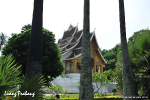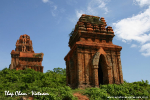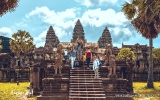Daun (Grandma) Penh brought the statues ashore and ordered people to pile up earth northeast of her house. She then used the Koki trunks to build a temple on the hill to house the five Buddha statues, and named the temple after herself as Wat Phnom Daun Penh, which is now known as Wat Phnom, a small hill of 27 metres in height.
Phnom Penh was also previously known as "City of Four Faces". This name refers to the junction where the Mekong, Bassac, and Tonle Sap rivers cross to form an "X" where the capital is situated.
Despite its recent turbulent history, Phnom Penh’s wide tree-lined boulevards and faded colonial mansions hold an undeniable charm and now, Phnom Penh is becoming the nation's center of economic and industrial activities, as well as the center of security, politics, cultural heritage, and diplomacy of Cambodia.
Notes:
Walking can be a challenge. Remember little gives way to big here, pedestrians come last, even on the now cluttered, once grand, wide, French-built pavements! To cross safely, judge gaps in the traffic and proceed with care - give oncoming vehicles ample time to see and avoid you, or try to cross with the brightly colored and revered monks. There is almost no street lighting off the major boulevards, and walking at night is not recommended. Traffic signals and pedestrian crossings are generally ignored by drivers.
Tuk Tuk is very popular transportation in Phnom Penh, They are cheap (Per tuk-tuk: US$1-3 for a trip in the city, $7 to the airport) and plentiful. Negotiate the price ahead of time and make sure the driver knows how to get to your destination. Driving standards vary. Drivers in tourist areas usually speak some English, but if going to a destination that is not well known it is best to make sure the driver really understands. Drivers generally do not know their way around and may stop to ask for directions.
Time to visit: Like most of Southeast Asia, Cambodia varies from warm to very hot throughout the whole year. There are four annual seasons: cool and dry between November and February; hot and dry between March and May; hot and wet between June and August; and cool and wet between September and early November. The best time to visit is the cool season, when the weather usually benefits from a pleasant dry heat and the countryside is still green from the rains. As February turns into March, the heat begins to build until April and May, when it can be quite oppressive and uncomfortable. In May and June, the rains come and bring a measure of relief. It rarely rains all day, and mostly it will rain for an hour or two in the afternoon or evening. By early September, the heat begins to dissipate and the evenings are cooler. Through October, the frequency of the showers slows and the humidity starts to lower. Although the wet season is low season for tourism throughout most of the region, visiting at that time does have its advantages.
Highlights:
For tourists and locals alike, the lively riverfront – a wide grassy promenade that runs beside the Tonle Sap for nearly 2km – is the city’s focal point. In the evenings, Phnom Penh residents come here to take the air, snack on hawker food and enjoy the impromptu waterside entertainment; the strip also shows the city at its most cosmopolitan, lined with Western restaurants, cafés and bars. Three key tourist sights lie close by. Arguably the most impressive of the city’s attractions is the elegant complex housing the Royal Palace and Silver Pagoda. The palace’s distinctive four-faced spire towers above the pitched golden roofs of its Throne Hall, while the adjacent Silver Pagoda is home to a stunning collection of Buddha statues. A block north of the palace is the National Museum , a dark-red building set in leafy surroundings housing a fabulous collection of ancient Cambodian sculpture dating back to as early as the sixth century. Also near the river are a number of lesser attractions, including Wat Ounalom, one of five pagodas founded during Phnom Penh’s first spell as the capital, and bustling hilltop Wat Phnom , one of the city’s prime pleasure spots, whose foundation is said to predate that of the city. The old French administrative area surrounds the hill on which Wat Phnom sits, with many fine colonial buildings , some restored. Also on many tourist itineraries, though for completely different reasons, is the Toul Sleng Genocide Museum south of the center; a one-time school that became a center for the torture of cadres who fell foul of the Pol Pot regime.
South of the center, the area around Independence Monument is a plush residential district and contains further monuments and a restful park. Two disparate attractions lie in the far south of the city: a short moto ride from the center is the disturbing Toul Sleng Genocide Museum, with its sobering evidence of the paranoia and inhumanity of Pol Pot and his followers; fifteen minutes’ walk further south, Psar Toul Tom Poung (Russia Market) has the best souvenir-shopping in the country. Especially poignant if you’ve visited the Genocide Museum is a trip to the killing fields at Choeung Ek, where a memorial stupa contains the remains of some of those murdered here.
{mainvote}






